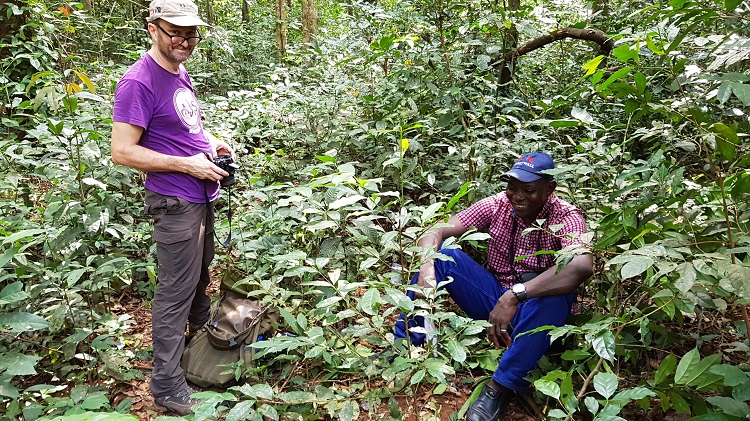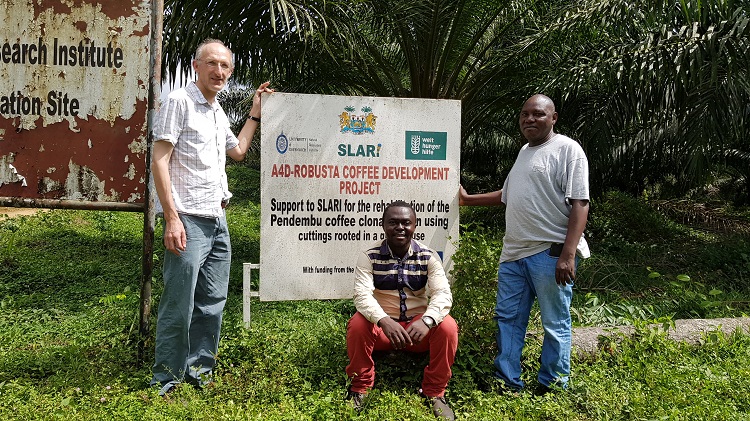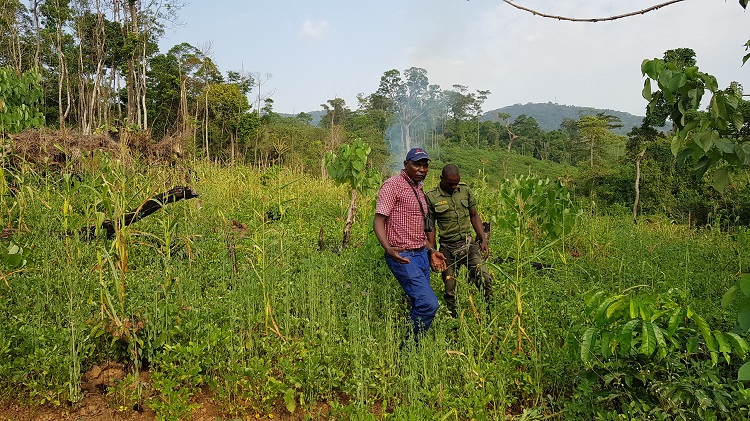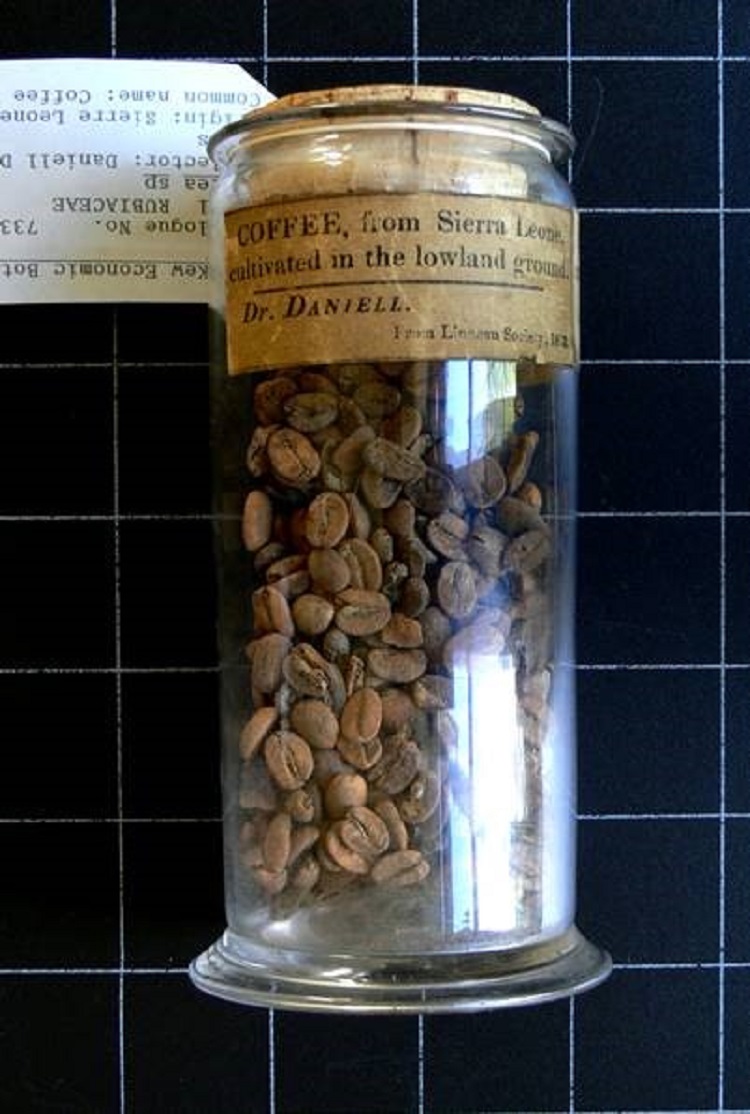In a paper recently published in ‘Nature Plants’, scientists from Sierra Leone, NRI at the University of Greenwich, Royal Botanical Gardens Kew and CIRAD (the French Agricultural Research Centre for International Development), reveal the results of an in-depth evaluation of a ‘rediscovered’ coffee species that has the potential to help futureproof the coffee industry against climate change. NRI’s Professor Jeremy Haggar - co-author of the paper - takes up the story.
 There are several records from the mid-1800s through to about 1920 of Sierra Leone exporting a native coffee which was hugely in demand from French buyers, and others who considered it as good as the “best mocha” and possibly superior to all other coffees. Could Sierra Leone once again become a sought after producer of speciality coffee?
There are several records from the mid-1800s through to about 1920 of Sierra Leone exporting a native coffee which was hugely in demand from French buyers, and others who considered it as good as the “best mocha” and possibly superior to all other coffees. Could Sierra Leone once again become a sought after producer of speciality coffee?
The coffee mentioned in these reports is the highland coffee of Sierra Leone or scientifically Coffea stenophylla. Native to Sierra Leone, Guinea and Ivory Coast, it was produced and exported from these countries alongside larger volumes of lower quality Liberica or Liberian coffee. Although stenophylla coffee was spread around the world as a potential lowland coffee, it would appear it was never established commercially due to its lower productivity compared to the newly discovered and rapidly spreading robusta coffee which is high in yield and strong in caffeine. We presume that even in its native Sierra Leone, stenophylla was displaced by the easy-to-farm robusta.
Up until the civil war in Sierra Leone (1991–2002), robusta coffee was a major agricultural export for Sierra Leone, with around 20,000 tonnes exported per year. Over the past decade exports have fluctuated at around 2,000 tonnes per year. Although there are probably over 30,000 smallholders who produce coffee, the productivity of their plantations is low, at an average of just 50kg per hectare, generating only about US$100 in income per family. While low coffee prices persist, there is little incentive for farmers to invest in improving their plantations.
past decade exports have fluctuated at around 2,000 tonnes per year. Although there are probably over 30,000 smallholders who produce coffee, the productivity of their plantations is low, at an average of just 50kg per hectare, generating only about US$100 in income per family. While low coffee prices persist, there is little incentive for farmers to invest in improving their plantations.
Between 2013–2016, while we were working on a project in Sierra Leone, in collaboration with the German development NGO Welthungerhilfe (WHH), to rehabilitate robusta coffee production and exports, we heard that there was a native coffee. Through our network of collaborators across Eastern Province we asked people to send us samples of unusual coffees. At the Sierra Leone Agricultural Research Institute Station in Pendembu they have a coffee collection, but the plants they thought were stenophylla coffee did not quite match the botanical characteristics; however, later, through genetic analysis we established they were hybrids between stenophylla and Liberica coffee. From other locations, we received many strange coffee samples, but all turned out to be variations of robusta or Liberian coffee.
 Finally in 2018, in collaboration with wild coffee expert Dr Aaron Davis from Royal Botanical Gardens Kew, we went looking for stenophylla coffee in the forest. Eventually we found a small population in a forest reserve in Eastern Provence, but there were no fruits and thus no way for us to find out whether its fabled high quality was true. Eventually in 2020, we were able to find enough plants with ripe fruits to collect a small sample for tasting. This one small sample of a few 10s of grams of coffee produced five small cups of coffee that were distinct and delightful.
Finally in 2018, in collaboration with wild coffee expert Dr Aaron Davis from Royal Botanical Gardens Kew, we went looking for stenophylla coffee in the forest. Eventually we found a small population in a forest reserve in Eastern Provence, but there were no fruits and thus no way for us to find out whether its fabled high quality was true. Eventually in 2020, we were able to find enough plants with ripe fruits to collect a small sample for tasting. This one small sample of a few 10s of grams of coffee produced five small cups of coffee that were distinct and delightful.
So what does this mean for the future of coffee production in Sierra Leone; could it once again become a source of a highly regarded and much sought after coffee? If you are hoping for a cup of this coffee on your table, you will have to be patient. Currently we only know of a few dozen wild plants. All available seed is being used by WHH to establish plants in nurseries, which will start the process of bringing this species back into cultivation in Sierra Leone.
We have much to learn, or relearn, about how best to grow and harvest this plant, for example, how long it will take to start producing a crop, and what the yield might be. It’s going to take about five years before we have the first trial plantations, by which time we hope to have enough sacks of coffee to fulfil the needs of a few specialty buyers. Within ten years, our aspiration is to have enough coffee to fill at least one shipping container.
going to take about five years before we have the first trial plantations, by which time we hope to have enough sacks of coffee to fulfil the needs of a few specialty buyers. Within ten years, our aspiration is to have enough coffee to fill at least one shipping container.
Alongside our efforts to bring stenophylla coffee back into cultivation, at the same time, it is critical to conserve the few wild populations that we know of in the wild, which are essential to the future of this crop species. This can be helped by strengthening the awareness of communities living near the forest of the importance of conserving their local natural environment, but also by ensuring they have the opportunity to benefit from the forest. Support is needed to work with communities, and the national forestry, agriculture and conservation institutions, to develop a plan for the conservation and use of stenophylla coffee.
Equally, investment is needed to develop new plantings, which will benefit those smallholders who have farms that are suitable for this crop. Its production must be undertaken sustainably, under the shade of trees in agroforestry systems, as traditionally undertaken in Sierra Leone for the farming of both coffee and cocoa.
Ensuring quality will not only rely on the right growing conditions, but will also require good processing and quality control. Over recent years coffee traders in Sierra Leone have been working on improving quality for robusta coffee, but it will be even more important to do this for stenophylla coffee, to ensure its full potential is realized. We must not expect high productivity, but if the potential high quality of stenophylla coffee can be attained and maintained, prices should more than compensate and local producers will benefit.
There is still a long road to travel, but maybe within a decade Sierra Leone can once again return as a country of origin for the coffee connoisseur, and at the same time improve the income of its farmers.
Watch Professor Jeremy Haggar on CNN
To find out more about:

